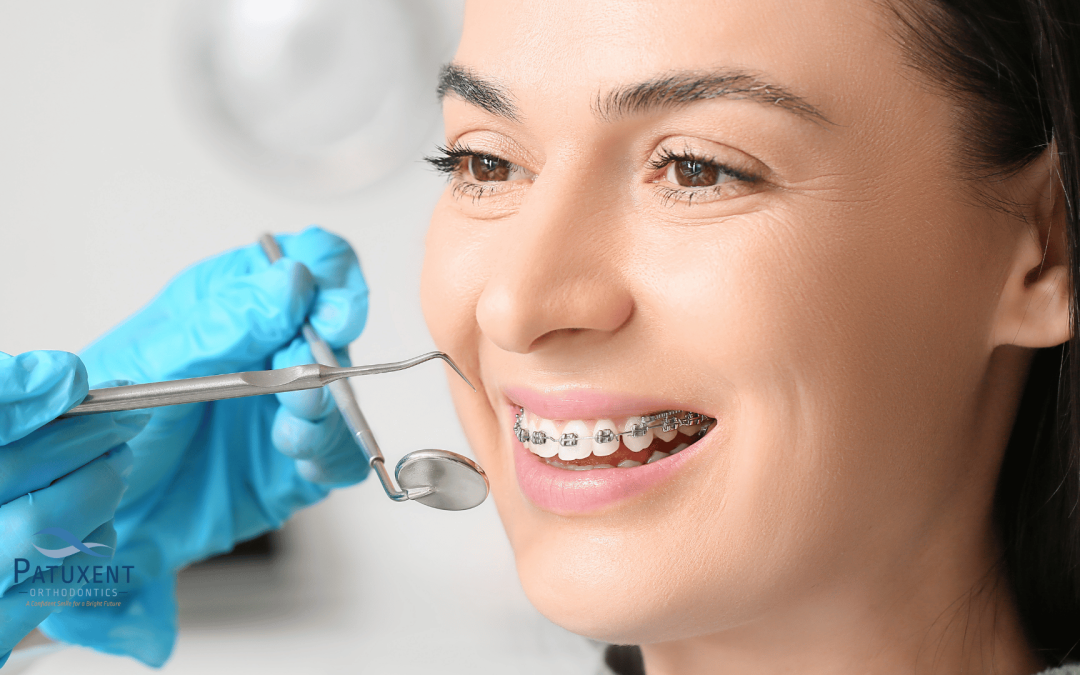- What Are Self-Ligating Braces?
- The 2 Types of Self-Ligating Braces
- How Do Self-Ligating Braces Differ from Traditional Metal Braces?
- Should I Get Self-Ligating Braces?
- 6 Orthodontic Issues Addressed through Self-Ligating Braces
- 7 Benefits of Self-Ligating Braces
- 5 Drawbacks to Self-Ligating Braces
- FAQ about Self-Ligating Braces
- Turbocharge Your Orthodontic Treatment with Self-Ligating Braces!
- References
Did you know there’s a modern twist on the traditional braces we’re used to seeing?
Enter self-ligating braces!
These state-of-the-art orthodontic appliances have some cool features, setting them apart from their traditional counterparts.
Without using those tiny elastic bands we’re all familiar with, self-ligating braces have a unique way of holding the wire in place, making the journey to a straight smile different.
Let’s dive into self-ligating braces and discover what makes them stand out in the orthodontic world!
What Are Self-Ligating Braces?
Self-ligating braces are an orthodontic appliance used to straighten teeth and correct bites. Think of them as close cousins to the regular braces you might see on many of your friends.
The big difference to traditional metal braces? How they hold onto the wire that moves your teeth.
Unlike conventional braces, which use tiny rubber bands to hold onto a wire, self-ligating braces have a unique clip performing this job. This clip securely holds the wire responsible for tooth movement.
Self-Ligating Braces Materials

First off, we have the classic metal.
Durable, sturdy, and ready to take on all the challenges of daily munching, metal self-ligating braces resemble the tough kids on the playground.
Next, there’s the ceramic option—the undercover agents of the braces world. They’re tooth-colored, making them more discreet and blending in with your teeth.
While they’re doing a fantastic job, ceramic braces are more delicate than their metal counterparts.
The 2 Types of Self-Ligating Braces

Active Self-Ligating Braces
Active self-ligating braces, often called “active brackets,” are like the go-getters. These brackets employ a clip that securely holds the orthodontic wire.
What makes them “active” is how they apply pressure on the teeth. The design of the active brackets allows them to use a consistent force on the teeth, gently guiding them toward their desired positions.
Passive Self-Ligating Braces
Passive self-ligating braces, or “passive brackets,” are the chill, laid-back counterpart to the active brackets.
Instead of holding the wire tightly, these brackets allow it to move freely within the slot. This approach allows less friction, making it easier for your teeth to glide into place—a significant advantage in the early stages of treatment.
How Do Self-Ligating Braces Differ from Traditional Metal Braces?

How They Hold the Wire
- Traditional braces use tiny bands to hold the wire in place. It’s like each tooth gets its own little elastic hat.
- Self-ligating braces have a built-in door or clip. Think of each tooth as having its own garage door, and the wire parking right inside.
Friction Factor
- Traditional braces create more friction because of their rubber bands.
- Self-ligating braces’ unique design often reduces the friction factor.
Adjustment Appointments
- With traditional braces, you will have to go on orthodontic visits more often to change or adjust your rubber bands.
- Self-ligating braces require fewer adjustments—a bonus if you aren’t a huge fan of orthodontic appointments.
Appearance
- Traditional braces are more noticeable, with clear or colorful bands on each bracket.
- Self-ligating braces offer a sleeker look without any bands.
Cleaning
- Traditional braces are more challenging to clean because of their rubber bands. You’ve got more nooks and crannies to navigate.
- Without the bands, self-ligating braces are easier to brush and floss.
Should I Get Self-Ligating Braces?

Ideal candidates for self-ligating braces include:
- Patients Looking for Fewer Visits: One of the cool things about self-ligating braces is that they require fewer trips to the orthodontist for adjustments. If you have a busy schedule, this could be a win for you!
- Patients Who Want a Sleeker Look: Without the rubber bands, self-ligating braces offer a cleaner, more streamlined appearance.
- Patients Concerned About Oral Hygiene: Self-ligating braces are easier to clean since there aren’t those pesky rubber bands in the way.
- Patients Looking for Faster Results: Some patients find their treatment time shorter with self-ligating braces.
6 Orthodontic Issues Addressed through Self-Ligating Braces

- Crowding: When your teeth are having a bit of a party, and there’s not enough room for everyone.
- Spacing: The opposite of crowding—your teeth are staying too far apart.
- Overbite: When your upper front teeth take center stage and jut out over the lower ones.
- Underbite: The lower front teeth take the lead role, sticking out past the upper ones.
- Crossbite: A mismatched bite where your top teeth fit inside the bottom ones instead of outside.
- Misplaced Midline: When the center of your upper and lower teeth don’t line up for their perfect selfie moment.
7 Benefits of Self-Ligating Braces

- Fewer Orthodontist Visits: That means more free time to do fun stuff, like binge-watching your favorite shows or mastering a new hobby.
- A Sleeker Look: Without those tiny rubber bands, self-ligating braces offer a cleaner, more streamlined appearance.
- Faster Treatment Time: Some patients find their treatment time is shorter than traditional ones.
- Less Friction: This benefit leads to more comfortable tooth movement.
- Easier to Clean: The absence of rubber bands makes brushing and flossing less of a challenge.
- Less Discomfort: With their unique design and reduced friction, patients find self-ligating braces more comfortable than traditional ones.
- They Work for Various Orthodontic Issues: From crowding to spacing and everything in between, self-ligating braces tackle various orthodontic challenges.
5 Drawbacks to Self-Ligating Braces

- Cost: Self-ligating braces are slightly pricier than traditional braces.
- Not Always the Best for Complex Cases: While these braces are great for many orthodontic issues, there might be superior choices for more complicated cases.
- Appearance: Although self-ligating brackets look sleeker than traditional braces, they’re still pretty noticeable, especially if you opt for the metal version. If you’re aiming for something ultra-discreet, other options like SPARK and Invisalign clear aligners might be more up your alley.
- The Learning Curve: There’s a learning curve for cleaning and caring for self-ligating braces. Sure, the absence of rubber bands makes things a tad easier, but you’ll still need to learn the ropes.
- Might Not Be Faster for Everyone: We mentioned that some patients finish their orthodontic treatment sooner with self-ligating braces. But here’s the thing: it doesn’t happen for everyone, so keep your expectations in check.
FAQ about Self-Ligating Braces
How Much Do Self-Ligating Braces Cost?
Self-ligating braces come with some cool features, like those clips or doors holding the wire in place without any rubber bands. Because of these features, they often come at a higher price than traditional braces.
“How much more are we talking about?” It varies.
For starters, your location plays a role in the price.
Another thing to consider is the orthodontist’s expertise and reputation. An experienced or reputable orthodontist might charge more for their services.
Duration of treatment is another factor. The longer you need self-ligating braces, the more they might cost.
Finally, let’s remember the material. Ceramic braces are pricier than their metal counterparts.
But here’s a silver lining: many orthodontic offices offer payment plans. Furthermore, some dental insurance plans cover parts of the treatment.
Can I Customize the Color of My Self-Ligating Braces?
Unlike traditional braces that use tiny colored rubber bands to hold the wire in place, self-ligating braces use a special clip or door. This means there’s no need for those little rubber bands.
Even without rubber bands, self-ligating braces still have options for those wanting a dash of color.
While metal brackets are silver and shiny, tooth-colored ceramic ones blend in with your teeth, creating a subtle appearance.
Even though self-ligating braces don’t typically use colored rubber bands, some orthodontists will let you add them purely for the sake of style! So, if it’s Halloween, and you’re feeling the spooky vibes, you may rock some orange and black bands. Or maybe you’ve got school spirit and want to flash your school colors every time you smile. The world is your oyster!
Will Self-Ligating Braces Speed Up My Orthodontic Treatment?
While speeding up your orthodontic care with self-ligating braces sounds promising, the real-world results can vary.
The speed of your orthodontic treatment isn’t just about the braces you choose. It also depends on the complexity of your case, how well you follow your orthodontist’s instructions, and how your teeth naturally respond to movement.
Chatting with an orthodontist is the best way to get an idea about the length of your orthodontic treatment. They’ll be able to give you the lowdown based on your specific needs.
Do Self-Ligating Braces Cause Discomfort?
The whole point of braces is to move your teeth into better positions. That movement is bound to cause some discomfort, no matter which type of braces you pick. It’s like when you start a new exercise routine, and your muscles are sore for a few days.
Self-ligating braces have a reputation for causing less discomfort than traditional braces.
Why? It boils down to their design.
Instead of relying on rubber bands to hold the wire in place, they use a unique clip or door mechanism. This design reduces the pressure on each tooth, leading to less discomfort.
Everyone’s discomfort tolerance is different. Some patients find self-ligating braces a breeze, while others notice soreness, especially after adjusting them.
The initial days after getting braces are the most challenging, as your mouth is getting used to this new foreign object. But the positive news is that this feeling gradually eases as the first few days go by!
How Do I Keep My Self-Ligating Braces Clean?
Self-ligating braces are designed with cleanliness in mind!
Self-ligating brackets are easier to clean, not because they are smaller, but because of the absence of bacteria-ridden rubber bands.
However, just because they’re a bit easier to clean doesn’t mean you get to skip out on a thorough cleaning routine.
First up, brushing.
Consider brushing after every meal to ensure no sneaky food bits are hiding around. Grab a soft-bristled toothbrush and gently scrub away. Being gentle is the keyword here; you don’t want to damage your braces or irritate your gums.
Next, we’ve got flossing.
Floss threaders are your best friend during this time, helping you navigate the floss between the teeth and under the wires.
Don’t forget about rinsing.
Swishing antimicrobial or fluoride mouthwash helps remove any leftover bacteria and gives you a refreshing feeling.
Lastly, regular dental check-ups are essential. They ensure everything runs smoothly, catching and fixing any minor issues early.
Do Self-Ligating Braces Require Adjustments?
Yes, self-ligating braces do require adjustments. But here’s the exciting news: they need fewer adjustments than traditional braces.
Self-ligating braces hold the orthodontic wire in place without any elastic bands. Their brackets allow the wire to move more freely, so they work efficiently without regular tune-ups.
Just because they need fewer adjustments doesn’t mean you get to skip your orthodontist visits. Orthodontists regularly need to check on your treatment progress and make those necessary adjustments to keep your treatment on track.

Turbocharge Your Orthodontic Treatment with Self-Ligating Braces!
Contact Patuxent Orthodontics if orthodontic care is the solution to your dental woes. Whether you want to learn more about the benefits of orthodontic care or have questions about the process, use our live chat, call (240) 802-7217, or message us through our Contact Us page to connect with our friendly staff today and book a complimentary consultation!
Our office, located at 44220 Airport View Dr., Hollywood, MD 20636, proudly serves Maryland’s Patuxent area, as well as the Greater Washington DC area. So, if you’re residing in Hollywood, Wildewood, or Leonardtown and are looking for one of the best orthodontists in Maryland, don’t hesitate to visit our office!
We also invite you to keep up with our blog to get answers to many of the frequently asked questions about maintaining your perfect smile, and follow us on Facebook and Instagram to become a part of our smiling community!
References
- Cohen, Dr. Charles. “Self-Ligating Braces: Costs, Pros & Cons, vs. Traditional, Colours & More.” Braces Haven, 27 June 2019, braceshaven.com/self-ligating-braces/. Accessed 27 Oct. 2023.
- Rooz, Dr. “Self Ligating Braces: Orthodontist Insights.” Modern Orthodontic Clinic in Sammamish & Bellevue, 19 July 2022, porth.io/education-hub/everything-you-need-to-know-about-self-ligating-braces/amp/. Accessed 27 Oct. 2023.
- Seladi-Schulman, Jill. “Self-Ligating Braces: How They Differ, Benefits, Cost.” Healthline, Healthline Media, 1 Mar. 2021, www.healthline.com/health/dental-and-oral-health/self-ligating-braces. Accessed 27 Oct. 2023.
- “Self-Ligating Braces vs Conventional Braces – Self Ligating Braces.” NewPark Orthodontics, 13 Sept. 2023, newparkortho.com/self-ligating-braces-better-than-conventional/. Accessed 27 Oct. 2023.
- “Self-Ligating Braces vs Metal Braces: Cost, Pros & Cons, Pictures, Faqs.” Diomondbraces-Navigation, www.diamondbraces.com/braces/self-ligating-braces/. Accessed 27 Oct. 2023.
- “The Complete Guide to Self Ligating Braces.” Premier Orthodontics, 19 Oct. 2021, yourazbraces.com/complete-guide-to-self-ligating-braces/. Accessed 27 Oct. 2023.











